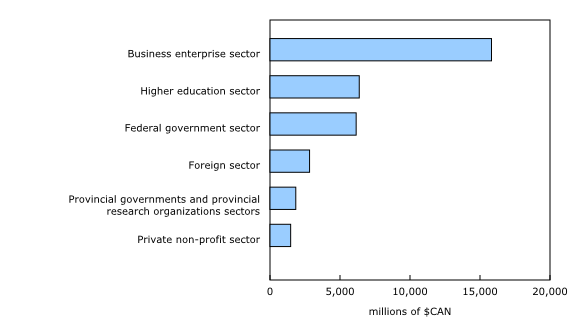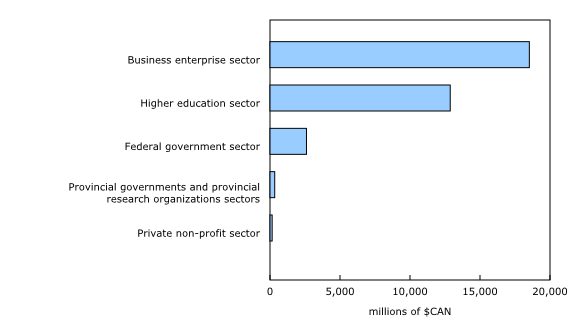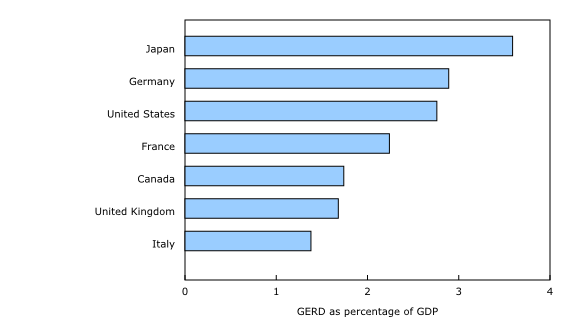Spending on research and development, 2016
Archived Content
Information identified as archived is provided for reference, research or recordkeeping purposes. It is not subject to the Government of Canada Web Standards and has not been altered or updated since it was archived. Please "contact us" to request a format other than those available.
Released: 2017-06-23
33.9 billion
2016
-0.1% 
(year-over-year change)
Canada's gross domestic expenditures on research and development (GERD) fell from $34.5 billion in 2014 to $33.9 billion in 2015. Intentions for 2016 show that gross domestic expenditures are anticipated to remain virtually unchanged from 2015 estimates.
Business enterprise sector is the largest performer and funder of research and development spending in 2014
In 2014, over half ($18.5 billion or 54%) of all domestic research and development (R&D) spending was performed by the business enterprise sector. This was followed by the higher education sector ($12.9 billion or 37%).
The business enterprise sector was also the largest funder of R&D expenditures, providing $15.8 billion or 46% of total gross domestic expenditures. Far behind this sector were the higher education sector and the federal government sector, each making up about 18% of total expenditures.
Ontario accounted for the largest portion of R&D spending in 2014
On a provincial basis, Ontario led research and development spending in 2014, accounting for 44% or $15.2 billion of GERD, followed by Quebec (26%) and Alberta (11%).
Spending on R&D by field of science
Canada's gross domestic expenditures on R&D consist of two fields of science: natural sciences and engineering, and social sciences and humanities. The natural sciences and engineering field accounted for 90% or $31.1 billion of total national expenditure on R&D in 2014. These expenditures were up 7.0% compared with 2013. The business enterprise sector accounted for almost 60% of total R&D performed in this field of science in 2014.
R&D spending in the social sciences and humanities increased 0.6% from 2013 to $3.4 billion in 2014. The majority (91%) of R&D expenditure in this field of science was performed in the higher education sector.
An international perspective on Canada's R&D performance
Internationally, GERD as a percentage of a country's gross domestic product (GDP) is considered an indicator of the country's degree of R&D intensity.
Canada's ratio of GERD to GDP was 1.74 in 2014, up from 1.71 in 2013. According to the most recently published data of the Organisation for Economic Co-operation and Development (OECD), the OECD average ratio of GERD to GDP in 2014 was 2.40. The GERD to GDP ratio in the United States for 2014 was just above this average at 2.76, while South Korea had the highest ratio at 4.29, followed by Israel at 4.27 and Japan at 3.59. Japan led among G7 countries, whereas Canada ranked fifth among this group.
Note to readers
This release presents actual gross domestic expenditures on research and development for 2014, preliminary data for 2015 and intentions data for 2016 at the national level.
Data for gross domestic expenditures on research and development (GERD) are available in current and constant dollars for both performing and funding sectors by science type, province, territory and region in CANSIM table 358-0001.
There are six GERD performing sectors in Canada: business enterprises, private non-profit, higher education, federal government, provincial governments and provincial research organizations. The funding sectors are the same as the performing sectors, but also include the foreign sector.
Revised time-use coefficients have been applied to Statistic's Canada higher education research and development model, starting with the 2012 reference year. Data from previous years for the higher education sector are not comparable. GERD data prior to 2012 should be used with caution.
GERD data presented in this release are performance based and correspond to the sum of intramural research and development (R&D) expenditures reported by performing sectors. Funding sector data are derived from the source of funds indicated by the performing sectors. As a result, GERD funding sector values will not equal funding data collected and released by individual sectors.
Data for the provincial government performing sector are currently modelled and based on results from the 2011 Provincial Scientific Activities Survey. However, this release includes 2014 data on R&D activities performed by the provincial government of Quebec, as the province conducted its own survey and provided the information to Statistics Canada. Provincial research organization data are collected through a Statistics Canada survey.
Provincial and territorial expenditures are assigned to the province or territory in which the performing organization is located. Provincial and territorial funding sector expenditures represent R&D funding distributed in a province or territory. The funds do not necessarily originate from within the province.
The business enterprise data source for the gross domestic expenditure on research and development program has been redesigned, including concepts and methodology. Users should therefore exercise caution when comparing 2014 data with historical datasets.
Contact information
For more information, or to enquire about the concepts, methods or data quality of this release, contact us (toll-free 1-800-263-1136; 514-283-8300; STATCAN.infostats-infostats.STATCAN@canada.ca) or Media Relations (613-951-4636; STATCAN.mediahotline-ligneinfomedias.STATCAN@canada.ca).
- Date modified:




